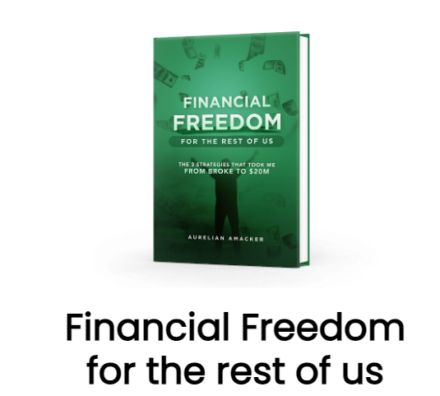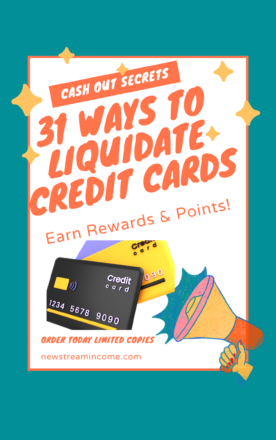I set out to write the best damn passive income ideas post on the Internet.
Because here’s the thing…
Most “passive income ideas” posts just repeat the same boilerplate ideas—open a high interest savings account, for example.
And yes, that will earn you a small amount of passive income, but my guess is you’re looking for something a little more substantial.
In this post, I’ll:
Share my own actual passive income streams.
Present other legit passive income ideas you can take action on today—and back those up with real-life examples.
Break down the 4 types of passive income and why it’s so important to start building today.
Ready?
Let’s dive in.
Too Many Choices?
Start here instead. Punch in your name and email below I’ll show you step-by-step how to add $500 to your bottom line.
Join the Free 5-Day $500 Challenge
You’ll also receive my best side hustle tips and weekly-ish newsletter. Opt-out anytime.
1. Earn Affiliate Commissions
I got my start in affiliate marketing back in 2004, and it’s been a significant piece of my revenue pie ever since.
How affiliate marketing works is I earn a commission for referring leads and customers to other products and services.
Suggested Playlist: Affiliate Marketing
Make money online by sharing relevant products and services with your audience. Here’s a killer playlist packed with actionable advice from the pros.
My first affiliate business was a comparison shopping site for footwear. It helped people find the best price on their next pair of shoes, and earned commissions from Zappos and other retailers when people made a purchase.
Once the site was built, I earned these commissions whether or not I was actively sitting at the computer.
Even today, affiliate marketing is a really important revenue stream for me. This site (and yes, this post too) includes lots of affiliate links to products, apps, services, and software I think will be helpful to my audience.
Here’s an (over-the-top) example of a post monetized with affiliate links. Still, over its lifespan, it’s generated over $40,000 in commissions. From one post!
2. Write a Book
It’s never been easier to create a book of your own and put it up for sale on Amazon.
I received my first author royalties in 2012 and have added several more titles since then. It’s one of my favorite side hustles and one of my most passive income streams. Write the book once and collect royalties for months or even years whenever it sells!
Over my lifetime as a professional self-published author, my books have earned over $75,000.
When you price your book between $2.99 and $9.99, you’ll earn a 70% royalty. Outside of that range, it’s 35%.
For every Kindle book you write, it probably makes sense to add paperback and audiobook editions. Thankfully, Amazon makes this incredibly easy with its KDP Print service and ACX, the Audiobook Creation Exchange.
Related: Free Self-Publishing Workshop
3. Buy Dividend-Paying Stocks
Investing for dividend cash flow has helped me get off the sidelines and into the market. (I’m the person who always thinks we’re due for a correction!)
My basic strategy has been to buy shares in companies with long histories of paying—and increasing—dividends. These include name-brand businesses like Target, Chevron, AT&T, and Proctor and Gamble.
These “boring” old companies aren’t likely to have explosive share price growth, but they do spin off consistent passive cash flow.
Over the last few years, I’ve slowly built this up to over $2,000 a month.
Check out a service like the modern brokerage M1 Finance to get started yourself.
You can trade stocks for free, or select one of their pre-built portfolios.
4. Sell an Online Course
In 2014 I created an online video course on Udemy about how to launch non-fiction Kindle books on Amazon. It earned $3500 in the first couple months, and has gone on to earn passive sales ever since.
The total is now over $27,000!
All I have to do is respond to the (pretty infrequent) student questions or comments. Again this falls under the model of “create something once, and sell it over and over again.”
What could you teach? Consider what people already ask you for help with. What do you know more about than the average person?
With services like Teachable, it’s never been easier to create and sell an online course of your own. These can command premium prices ($100-$2000 or more) and allow you to help more people than you could with one-on-one consulting.
Over the years on The Side Hustle Show, we’ve seen people making money with online courses on just about every topic imaginable. Some of the more creative case studies include:
Piano
Sourdough baking
Motorcycle repair
Getting dressed in the morning
Helping toddlers read
and so many more!
How will customers find you? If you don’t have an audience, one method to try is the YouTube-to-evergreen-webinar model, as described by Nate Dodson in this episode.
5. Buy Part of a Rental House
Arrived specializes in matching investors with truly passive rental properties across the country. The site allows you to buy shares in houses for as little as $100, and earn monthly cash-flow from the rent payments.
A couple friends of mine have purchased several houses through this easy-to-use site. I like the diversity of REITs, but if building a real estate empire is your long-term plan, these guys will help you do it—one house at a time.
6. Collect Ad Money from YouTube
If you have over 1000 subscribers and meet a couple other requirements on your YouTube channel, you can enable ads and start to get paid.
Lately this passive income steam has been around $400 a month:
To be sure, it takes time to create the videos, but once they’re uploaded, they can earn passive income for years—as some of mine have.
Suggested Playlist: Make Money Online
Here are some creative and inspiring ways you can make money online.
7. Sell Printables
I believe allocating some of your time to “passive income” pursuits is incredibly valuable. When the assets you build start paying off, you can slowly taper off trading time for money.
One of those is passive income ideas is selling printables through a platform like Etsy. Side Hustle Show guest Rachel Jones reported selling up to $10,000 a month worth of these digital files!
(Think meal planners, intake forms, chore charts, budgeting templates, etc.)
Here’s the online course Rachel credited with helping her get started.
8. Let Banks Give You Free Money
Credit card rewards are one my favorite passive income ideas because I earn them just from spending money like I normally would.
In our house, this stream is worth hundreds of dollars a year in the form of cash back, free Amazon gift cards, and travel.
The magic really happens when you take advantage of certain sign-up bonuses for new cards. You can earn the equivalent of 20%, 30%, 40% cash back or more in travel value or statement credit.
Here’s just a really simple example:
Credit cards like the Capital One Quicksilver Cash Rewards Credit Card offer a $200 sign-up bonus after you spend $500 in your first 3 months — with no annual fee. That’s up to 40% cash back!
Learn more and compare this card to other cash back cards here.
If you know you’re gonna spend $500 in the next 3 months, that’s #freemoney. This card also gives you one of the highest cash back rates, with unlimited 1.5% back on every dollar you spend.
Related: Credit Card Rewards 101: How to Earn Free Cash and Travel by Spending Smarter
9. Get Easy Cash Back
Aside from credit card rewards, I use several cash back apps to earn “reverse passive income” every time I shop.
Among those are:
Rakuten – This free shopping portal has been giving users cash back for over 20 years. Get a $30 bonus through our referral link.
Capital One Shopping – A free browser extension that helps you find better deals and coupon codes when you shop online. (Even if you don’t bank with Capital One.) Plus, you’ll earn rewards you can redeem for gift cards. Disclosure: Capital One pays me when you get the Capital One Shopping extension through my link.
Fetch Rewards – Scan your grocery receipts with the free Fetch app to earn cash back on 250+ brands. Not 100% passive but very painless.
DOSH – Link your bank and credit cards and earn automatic cash back at participating stores and restaurants.
10. Share Your Data
While not a huge money-maker, this simple passive income idea could be worth $200 a year or more. I figured since I’m probably already giving my data away to “big tech” for free, it would be cool to actually get paid for it.
For example, I earned $80 in my first few months on Caden. The app pays a daily “data dividend” for connecting accounts like Amazon, Uber, and Netflix.
Other passive income ideas in this category include Nielsen’s Computer and Mobile Panel, which pays up to $60 a year for sharing your Internet usage habits.
11. Sell a Digital Product
Jodi Carlson reported earning over $5k a month selling digital activity guides for Girl Scout troop leaders. She’d started a blog documenting the activities she was doing with her scouts, mostly just as a reference for herself and other local leaders.
Before long, troop leaders from the other side of the country had discovered her site through Google and Pinterest. They emailed asking what other ideas she had.
That’s when Jodi began compiling her activity guides into PDF documents. She uploaded them to Teachers Pay Teachers, a site to buy and sell lesson plans, and made several sales in the first week.
12. Make Product Review Videos
If you’re accepted into the Amazon Influencer Program, you can get paid to create short video product reviews.
In turn, Amazon displays those on the relevant product pages, and rewards you a commission when someone makes a purchase after watching your video.
I made over $700 doing this in my first few months, with very little effort! (After uploading, it’s totally passive.)
Plus, I’ve connected with other side hustlers earning $2,000 a month sharing their opinions on Amazon products.
13. Create Print on Demand Designs
This is a low-overhead, low-investment way to build a little passive income. In our house, Merch by Amazon is a fun little side business and generates around $50-200 a month for us.
How it works is you upload t-shirt (and now other product) designs to Amazon, and the e-commerce giant does the rest. When someone orders it, they’ll print it in the size and color selected, and ship it to the customer. You earn the spread between whatever price you set and the cost to print it.
Our best month was over $500 in profit, which I think we could hit consistently if we dedicated more time to creating new designs.
14. Buy Commercial Real Estate
Fundrise is a cool “alternative” way to invest in real estate.
With just a $10 minimum investment, you can start building a portfolio of pre-vetted commercial properties. I’ve been investing with them since 2015 and they’ve paid dividends every quarter so far.
(Disclosure: when you sign up, I earn a commission. All opinions are my own.)
Check out my full Fundrise review to learn more.
Curious about other alternative investments? Play around with this cool tool to see what else is out there:
15. Earn More Interest
Our free checking accounts with Chase are paying .01% interest. What’s even the point?
That’s why we keep most of our cash in higher-yielding savings accounts with Capital One and Betterment.
To add diversification and cash flow to my portfolio, I’ve also taken up a small position in Worthy Bonds.
These small business bonds pay 7% interest, and you can buy them for only $10 apiece. The bonds are used to fund inventory or asset-backed loans to small U.S. businesses.
Since the loans use inventory as collateral, they’re considered safer than other personal or business loans. You can also automatically re-invest your interest and make penalty-free withdrawals at any time.
Too Many Choices?
Start here instead. Punch in your name and email below I’ll show you step-by-step how to add $500 to your bottom line.
Join the Free 5-Day $500 Challenge
You’ll also receive my best side hustle tips and weekly-ish newsletter. Opt-out anytime.
16. Make Short-Term Real Estate Loans
With Groundfloor you help real estate flippers fund their acquisition and rehab costs. In return, you earn 6-9% passive income on your investment.
The big advantage over other peer-to-peer lending is the loans are backed by the real property. That means if the borrower stops paying, you have some recourse — namely foreclosure.
The loans are shorter term, generally 1 year or less, instead of 3-5 years.
17. Play the Substitution Game to Save Money
I’ve been a Mint Mobile customer for years. It runs on the T-Mobile network, and when you pre-pay, it costs just $15 a month:
Compared to my old provider, Ting, and my even older provider, Verizon, this represents savings of $180-500 a year.
Similarly, if it’s been more than 2 years since you last shopped for car insurance, you’re paying too much.
Check out Insurify for a quick and painless comparison on car and home insurance. It’ll take just a few minutes and users report saving an average of $489 per year!
What other recurring monthly costs could you cut by negotiating with your service provider or by shopping for a similar service?
18. Refinance or Pay Down High Interest Debt
According to Nerd Wallet, the average household with debt is facing:
$7,800 in credit card debt
$29,000 in vehicle debt
$59,000 in student loan debt
If you’re paying any non-mortgage interest right now, I would prioritize reducing or eliminating that monthly expense before exploring these other strategies.
19. Flip Raw Land
To be fair, this passive income idea is a ton of work upfront, but done right, you’ll be collecting payments for years.
The basic idea, as explained by Roberto Chavez on The Side Hustle Show, is to buy parcels of vacant land at a discount, and then to re-sell that property on a monthly payment plan.
20. Rent Out Extra Stuff
I love creative rental businesses, like Lenny Tim’s mobility scooter rental business. It brings in $3,000 a month as a side hustle.
What’s even more interesting is he didn’t go out and buy his first scooter until he had proven the demand. He built out a website and waited until it started to get a steady flow of booking requests!
Here are some other items you could potentially rent out for a profit:
Your car. The average vehicle sits idle about 22 hours a day. Sites like Turo make it easy to get started.
Your RV. The “idle time” stats for RVs are even worse than for cars. RVShare facilitates peer-to-peer rentals and covers insurance, with prices ranging from $150-300 a night!
Your boat. Rates range from $230 to $950 per day on sites like Boatsetter.
Your gear. Babyquip rents quality used baby gear to traveling families. Meanwhile, FatLlama has gone broader, using the slogan “Airbnb for your stuff.”
21. Subcontract a Service Business
Chris Schwab started a residential house cleaning business back when he was still in college. In less than two years, he’d grown it to $60,000 a month—all while never mopping a floor or dusting a shelf himself.
Despite dozens of competing cleaning services, Chris discovered there was still opportunity. He figured that out while perusing Yelp reviews of existing cleaning companies.
“No one complained about the cleaning itself,” he said. “What people complained about was the customer service. They didn’t know when the crew was going to show up; they couldn’t get a quote; no one was answering the phone. I knew I could do that, and find cleaners to do the actual work.”
Since then, he’s delegated much of the customer support as well. When we caught up, the business took just a few minutes a day for him to manage.
22. Build a Helpful Website
Now to be totally upfront, there’s a lot to learn to make this business work, but when it does, it can be extremely lucrative.
For example:
Scott earns 6-figures a year from his bird-watching blog
Shelley earns $50k a month from her travel blogs
Andrew earned over $1.2M from his gift ideas site
Their sites are monetized with advertising and affiliate partnerships, which scale as your traffic increases.
Want to start a blog of your own? Check out my free 6-part video course on how to start your own site.
Pros:
Low startup costs
Great long-term earning power
Can sell the business down the road
Cons:
Slow to see results
Lots of skills to learn
23. Buy a Cash-Flowing Website
As I can attest, blogs and websites can earn great semi-passive income without your direct involvement. But you also usually can’t stand still for long before that income starts to fade.
Things break, content needs updating, and Google rankings are always changing.
Still, if you have web skills, you might like this interview with Stacy Caprio. She bought enough cash flow in the form of existing websites from the Flippa marketplace to quit her job.
24. Buy a “Boring” Business
Since half of all new businesses fail within the first 5 years, perhaps it makes sense to buy one that’s already proven successful.
And if online businesses aren’t your thing, take a look around your town.
For example, Hannah Ingram bought a local car wash with no money down using seller financing. When we spoke, it was profiting an average of $5,000 per month, with just a few hours a week of work.
You can shop on sites like BizBuySell to find opportunities near you.
Expect to pay 2-3x the annual earnings as a purchase price, but you can often finance up to 90% of the deal with an SBA loan.
25. Set Up a Vending Machine
Vending machines are one of the oldest passive income ideas. They’re literally robots that collect money when you’re not around!
The challenge is managing inventory and keeping the machines stocked, especially if you have several locations. Still, the thought of returning to a machine and finding it filled with money is pretty motivating.
For more on how the vending machine business can work, check out my interview with Matt Miller, whose passive income empire started with just $36 and a bag of gumballs.
26. License Your Ideas
Product licensing is a unique way earn residual income from your ideas—while letting someone else do the work.
For example, Nate Dallas and his brother split $300,000 in royalties from a Pictionary-inspired card game they licensed to Mattel.
The duo (a dentist and a preacher) didn’t have to design it, produce it, or sell it—but they found someone who could—and they cashed the checks.
Other things you can license:
Photography
Music
Voice over work
27. Set up a Drop Shipping Store
Drop shipping is a unique type of e-commerce where your supplier actually ships the products to customers on your behalf. As the seller, you don’t have to purchase any inventory until you have a buyer. Your profit comes from spread between the retail price you charge and the wholesale price you’ve agreed upon with your supplier.
In one of the most popular Side Hustle Show episodes of all time, Rene Delgado broke down how he sold $300,000 worth of bounce houses in his first year as a drop ship store owner.
Although there is a lot of upfront work in building the site and securing supplier relationships, drop shipping can be relatively passive after that.
28. Develop an App or Software
Could you solve a problem with software? It’s the ultimate scalable business in that the same underlying code can be sold to an unlimited number of customers.
A premium software tool can be sold either as a one-off purchase or a recurring monthly subscription.
As a customer, I’ve bought both smartphone apps and desktop software. If you don’t have the technical chops to build something like this yourself, you could always partner or hire someone who does—or white label software that already exists. The biggest consideration is to do your homework upfront and make sure there’s a hungry market demand for what you’re building.
Look to tools like AppSumo or ProductHunt to gain initial traction.
29. Develop an Alexa Skill
There are a couple ways side hustlers can make passive income with Amazon’s popular Echo devices.
The first is like Apple’s app store. You can build special Alexa voice apps, called “skills.”
As a skill developer, you can set your own price and earn 70% of the revenue when users buy it. For example, Nick Schwab has 10,000 paying customers for an ambient noise skill. He created a free version for people to try, and priced the paid version between $0.99 and $1.99 a month.
Amazon also has a rewards program to encourage developers to build out the ecosystem of skills. The rewards are based on the popularity and engagement of your skill, and some developers report earning thousands of dollars a month.
30. Rent Your Bandwidth
A new app called Honeygain has been building a lot “buzz” lately. According to the site, you can earn up to $30 a month when you share “your unused net traffic with data scientists.”
(Figures based on sharing 10 GB a day, which is a crap-ton of data!)
After you install the app (available on Windows, MacOS, and Android), connect it to the Internet, and earn rewards passively. On average, it takes users 48 days to reach $20.
Before you get started though, make sure you’re truly on an unlimited plan as it sounds like this could chew through a lot of bandwidth in hurry!
31. Rent Out Your Extra Space
You’re probably familiar with Airbnb and similar sites, where you can turn the extra space in your home into extra cash. Check the calculator on their site to see how much you could earn.
This gets more passive if you have a second property and hire a 3rd party service to manage your bookings, guest communication, and cleaning.
But if you don’t want to deal with guests at all, the Neighbor platform might be worth a look. Neighbor lets you store people’s extra stuff where you have space for it.
This is likely to be very passive monthly income after the initial drop off. Some hosts are earning up to $10,000 a year running their own mini self-storage operations.
Check out our full Neighbor review to learn more.
The 4 Types of Passive Income Ideas
The allure of passive income is exciting. I mean, if the idea of making money in your sleep doesn’t get you excited, I’d check your pulse.
On top of that, passive income is important.
I’ll let Warren Buffett explain:
“If you don’t find a way to make money while you sleep, you will work until you die.”
I think we can all get on board with that.
So how can you get some that sweet, sweet passive income—or “mailbox money”—for yourself?
Here’s what you need to know.
In general, passive income is the money you earn from assets you control. (Assets are simply things that other people value; cash, real estate, physical goods, attention, etc.)
The drawback is assets usually take either time to build or money to acquire.
Here are the 4 types of passive income you can start working toward today:
1. Buy cash-flowing assets
This is the “make money with money” option. Under this category you’ll find options like dividend investing, business lending, real estate, and stuff like that.
It’s great—if you already have money to invest!
2. Build assets
Building something of value—say, a digital product or website that earns advertising revenue—is a viable path to passive income. These things take some time to create and market, but can run relatively passively often for years if set up correctly.
3. Share or sell assets
There are ways to make relatively-passive income renting or selling assets you control.
This could include extra space around your house, stuff you have collecting dust, or even the data generated by your phone.
4. “Reverse” passive income
“Reverse” passive income comes from cutting your ongoing monthly expenses. A penny saved is a penny earned, right?
Well, because of taxes on earned income, it’s actually better than that! And there’s no extreme couponing required.
Why Passive Income Ideas Matter
I’m not an investment guru or financial wizard, but the vast majority of my income is “passive”—or at least time-leveraged.
By time-leveraged, I mean I don’t punch a clock or trade my time for money in any direct way.
I started my career the way most people do—with a job. But over time, I’ve consciously built up more passive income streams, while growing the overall size of the income pie as well.
The tiny sliver of “active income” on the chart comes from one-on-one consulting calls.
Unfortunately, here’s how the chart looks for most people:
They have a big chunk of active income—from their job—and (if they’re lucky) a little slice of investment income.
Let’s work toward shifting the balance to the green!
It’s important to note I’ve built these up slowly over time, starting while I was still working a 9-5 job. I don’t want to paint the picture that I’m raking in millions sitting in a hammock on the beach, either—because I’m not.
I still work a few days a week on growing my business. But I get to do it on my own terms and have a ton of fun doing it.
Conclusion: Start Building Your Passive Income Today
To recap, we’ve covered a couple dozen ways I earn passive income and shared a ton of other ideas for you to get started with today. These income streams didn’t happen overnight for me; they took years of dedicated effort to build.
But that effort is worth it. In fact, it’s required if you ever want to stop trading time for money.
My recommendation is to pick a few of the options on the list that seem most appealing and doable to you, and get started with those. Let me know how it goes!
Too Many Choices?
Start here instead. Punch in your name and email below I’ll show you step-by-step how to add $500 to your bottom line.
Join the Free 5-Day $500 Challenge
You’ll also receive my best side hustle tips and weekly-ish newsletter. Opt-out anytime.
Looking for More Side Hustle Help?
Start Your Free $500 Challenge. My free 5-day email course shows you how to add $500 to your bottom line.
Join the free Side Hustle Nation Community. The free Facebook group is the best place to connect with other side hustlers and get your questions answered.
Download The Side Hustle Show. My free podcast shares how to make extra money with actionable weekly episodes.
Pin it for later:
Frequently Asked Questions
What are the 4 types of passive income?
Passive income comes in 4 main varieties. 1. Investment returns. 2. Residual earnings from assets you build yourself. 3. “Renting” assets you already control. 4. “Reverse” passive income; that is, saving money on recurring expenses.
How do I generate passive income?
The most common way to generate passive income is through investment returns, such as share price appreciation, dividends, or real estate rental income. But perhaps more accessible is to build income-producing assets — like websites — of your own.
What are some examples of passive income?
Stock dividends, real estate rental income, advertising revenue, affiliate commissions, savings account interest, book sales, private lending, and tons more!
*********
Clip art provided by Freepik.


















